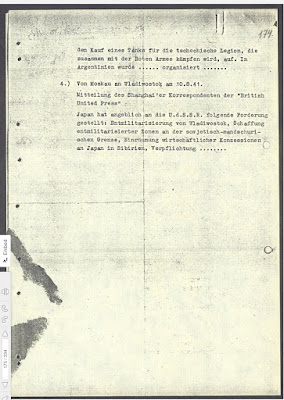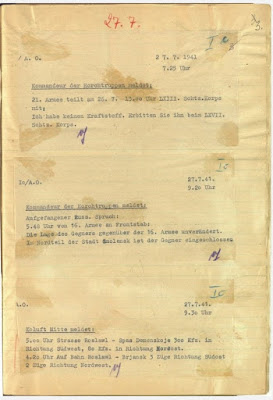Translated Pers Z reports from 1941
and 1942 confirm these statements (3). The 1941 report says that ‘all the Irish telegrams can be read
completely’ and 223 decoded telegrams were published. In 1942 126
decoded telegrams were published.
Military and intelligence history mostly dealing with World War II.
Monday, February 22, 2016
Tuesday, February 16, 2016
CryptoCellar Tales is active again
My friend Frode Weierud has started adding material in his
site CryptoCellar Tales. Frode
is an expert on WWII crypto history and few people know more on the subject.
Let’s hope that he continues to write about these cases.
Friday, February 12, 2016
Update on OSS communications from Bern, Switzerland
After going
through my files I’ve discovered more documents that have information on the
compromise of OSS communications in WWII. Thus the following paragraphs are
added in Allen
Dulles and the compromise of OSS codes in WWII:
Report of
Sturmbannführer Huegel
SS-Sturmbannführer
Dr. Klaus Huegel was an important SD official with knowledge of German intelligence
operations in Switzerland and Italy. In CSDIC/CMF/SD
20, he says that when he was working at the SD HQ he saw US intelligence
reports from Bern:
‘A daily bulletin from the German High
Command Cryptographic Service, OKW CHI, was sent to SS Brigadefuehrer
SCHELLENBERG, the Head of Amt VI of the RSHA. It was signed by Generalmajor
THIELE. From Apr 43 till Mar 44, source was in Amt VI, and often saw the
bulletins. He remembers that the following links were intercepted and their traffic
read, translations of matters of interest to Amt VI appearing in the bulletins:
USA Minister HARRISON in BERNE -
WASHINGTON: Three or four signals daily, on the average, were intercepted. All
traffic was read. This enabled Amt VI to judge the Swiss attitude to GERMANY as
seen through American eyes, and also gave a good picture of conditions in
GERMANY. Source says that Mr. HARRISON seemed to be particularly well-informed
on the situation in MUNICH, for instance on the morale of the people and on rifts
between various High Party officials, between GOERING and HIMMLER, RIBBENTROP
and HIMMLER, etc. A conclusion drawn on several occasions in the messages was
that though the population was restive, no organised underground resistance on
a large scale was possible because of the power of the SS and Gestapo and other
security bodies. Source says that Amt VI found these messages of great
interest, and if any points raised required investigation, it was often found
that the information had been correct.’
Under The
Finnish connection:
David Kahn
interviewed some of the Finnish codebreakers in the 1990’s (Aalto, Loimaranta,
Pale) and they clearly remembered US telegrams containing intelligence reports
and information on the German Resistance:
‘Q:
Why did you think the Americans used such weak codes?
A: They had no idea about that, the
question was why the ambassador's telegram, everything in ….. cipher or
ambassador send a list, a long, long telegram about conspiracy against Hitler
with all the names. It was a very, very terrible business,
Another voice: gave them away.
Q: Is that how they caught the
conspirators.’
Wednesday, February 10, 2016
Presentation on solution of historical ciphers
Here is a recent presentation on new methods of solution of
historical cipher systems by mr George Lasry.
Sunday, February 7, 2016
Well that was fast…
One of the
most interesting aspects of Cold War intelligence history is whether the spies
recruited by the Western intelligence agencies (mainly CIA and MI6) were
supplying real information or whether they were double agents. In his recent
article ‘Doubles
Troubles: The CIA and Double Agents during the Cold War’, Benjamin B.
Fischer (former Chief Historian of the Central Intelligence Agency) makes the
case that in Cuba, East Germany and the USSR practically all the CIA agents
were in reality under the control of the enemy security services.
The author
says:
‘During the Cold War the Central Intelligence
Agency (CIA) bucked the law of averages by recruiting double agents on an
industrial scale; it was hoodwinked not a few but many times. The result was a
massive but largely ignored intelligence failure. The facts are available from
official sources.’
I thought
that the article was very interesting and that’s why I linked to it back
in January. The article also mentioned Adolf Tolkachev, the
so called Billion
Dollar Spy. Fischer said:
‘The CIA touts Adolf Tolkachev as its
‘‘billion-dollar spy’’ during the 1980s, asserting that the Soviet electronics
researcher saved the Pentagon several times that amount in research and
development (R&D) and production costs with purloined information on Soviet
military radar and avionics. I believe, however, that Tolkachev was a double
agent, in fact the precursor to the dangles who came after his 1985 arrest………..Tolkachev was not the only double on the CIA’s
payroll. SE Division was handling another agent encrypted EASTBOUND, who also
was selling information on military radars. Soviet and East German sources have
confirmed that the anonymous agent was a double. I believe that Tolkachev and
EASTBOUND were fraternal twins.’
This article which
appeared in a journal with a limited readership seems to have attracted a lot
of attention. The 'great' researchers of the National Security Archive have immediately followed up with the transcripts of a Politburo discussion on Tolkachev.
I don’t know why this organization was so interested in this
case or how they were able to follow up Fischer’s
article so quickly. Since they have such 'superior' investigative skills they
could also look into the compromise of Allied codes and ciphers in WWII. That’s
research that I’d like to see!
Wednesday, February 3, 2016
German signals intelligence files in the Russian national archives
At the end of
WWII parts of the German state archives were captured by the Soviet forces and
taken to the Soviet Union. There they were placed in various Soviet state
archives and kept out of reach of researchers. With the fall of the Soviet
Union these archives were opened to researchers but not many people have taken
advantage of that. Thankfully some of these German documents have recently
become available online. The website of The
Russian-German project to digitize German documents in the archives of the
Russian Federation has uploaded a large number of German documents from WWI
and WWII.
The site
says:
‘As a result of the anti-Hitler coalition
victory in the Second World War, documents of Nazi Germany turned up in many
countries, including Russia. Largest collections of German documents are kept
in the Federal archives of the Russian Federation (State Archive of the Russian
Federation (GARF), the Russian State Military Archive (RGVA) and the Russian
State Archive of Socio-Political History (RGASPI)), and in the Central Archive
of the Russian Ministry of Defense (TsAMO). The project to digitize German
documents was initiated by the administration of the Russian President in 2011.
It is executed by the Russian Historical Society, the Ministry of Defense and
the Federal archival agency with support from the German Historical Institute
in Moscow. Coordination committee, overseeing the digitization project, is
headed by S.E. Naryshkin, the Chairman of the State Duma of the Federal
Assembly of the Russian Federation.’
Regarding
German sigint activities during WWII, the search terms ‘Nachrichten Aufklärung’ and ‘horchtruppen’ bring up many
interesting documents. For example:
Baudot
traffic
Reports of
Kommandeur der Horchtruppen Ost
Reports of
Nachrichten Aufklärung Auswertestelle 2
Subscribe to:
Comments (Atom)























